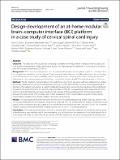| dc.contributor.author | Davis, Kevin C. | |
| dc.contributor.author | Meschede-Krasa, Benyamin | |
| dc.contributor.author | Cajigas, Iahn | |
| dc.contributor.author | Prins, Noeline W. | |
| dc.contributor.author | Alver, Charles | |
| dc.contributor.author | Gallo, Sebastian | |
| dc.contributor.author | Bhatia, Shovan | |
| dc.contributor.author | Abel, John H. | |
| dc.contributor.author | Naeem, Jasim A. | |
| dc.contributor.author | Fisher, Letitia | |
| dc.contributor.author | Raza, Fouzia | |
| dc.contributor.author | Rifai, Wesley R. | |
| dc.contributor.author | Morrison, Matthew | |
| dc.contributor.author | Ivan, Michael E. | |
| dc.contributor.author | Brown, Emery Neal | |
| dc.contributor.author | Jagid, Jonathan R. | |
| dc.contributor.author | Prasad, Abhishek | |
| dc.date.accessioned | 2022-06-06T13:38:33Z | |
| dc.date.available | 2022-06-06T13:38:33Z | |
| dc.date.issued | 2022-06-03 | |
| dc.identifier.uri | https://hdl.handle.net/1721.1/142881 | |
| dc.description.abstract | Abstract
Objective
The objective of this study was to develop a portable and modular brain–computer interface (BCI) software platform independent of input and output devices. We implemented this platform in a case study of a subject with cervical spinal cord injury (C5 ASIA A).
Background
BCIs can restore independence for individuals with paralysis by using brain signals to control prosthetics or trigger functional electrical stimulation. Though several studies have successfully implemented this technology in the laboratory and the home, portability, device configuration, and caregiver setup remain challenges that limit deployment to the home environment. Portability is essential for transitioning BCI from the laboratory to the home.
Methods
The BCI platform implementation consisted of an Activa PC + S generator with two subdural four-contact electrodes implanted over the dominant left hand-arm region of the sensorimotor cortex, a minicomputer fixed to the back of the subject’s wheelchair, a custom mobile phone application, and a mechanical glove as the end effector. To quantify the performance for this at-home implementation of the BCI, we quantified system setup time at home, chronic (14-month) decoding accuracy, hardware and software profiling, and Bluetooth communication latency between the App and the minicomputer. We created a dataset of motor-imagery labeled signals to train a binary motor imagery classifier on a remote computer for online, at-home use.
Results
Average bluetooth data transmission delay between the minicomputer and mobile App was 23 ± 0.014 ms. The average setup time for the subject’s caregiver was 5.6 ± 0.83 min. The average times to acquire and decode neural signals and to send those decoded signals to the end-effector were respectively 404.1 ms and 1.02 ms. The 14-month median accuracy of the trained motor imagery classifier was 87.5 ± 4.71% without retraining.
Conclusions
The study presents the feasibility of an at-home BCI system that subjects can seamlessly operate using a friendly mobile user interface, which does not require daily calibration nor the presence of a technical person for at-home setup. The study also describes the portability of the BCI system and the ability to plug-and-play multiple end effectors, providing the end-user the flexibility to choose the end effector to accomplish specific motor tasks for daily needs.
Trial registration ClinicalTrials.gov: NCT02564419. First posted on 9/30/2015 | en_US |
| dc.publisher | BioMed Central | en_US |
| dc.relation.isversionof | https://doi.org/10.1186/s12984-022-01026-2 | en_US |
| dc.rights | Creative Commons Attribution | en_US |
| dc.rights.uri | https://creativecommons.org/licenses/by/4.0 | en_US |
| dc.source | BioMed Central | en_US |
| dc.title | Design-development of an at-home modular brain–computer interface (BCI) platform in a case study of cervical spinal cord injury | en_US |
| dc.type | Article | en_US |
| dc.identifier.citation | Journal of NeuroEngineering and Rehabilitation. 2022 Jun 03;19(1):53 | en_US |
| dc.contributor.department | Massachusetts Institute of Technology. Department of Brain and Cognitive Sciences | |
| dc.contributor.department | Picower Institute for Learning and Memory | |
| dc.identifier.mitlicense | PUBLISHER_CC | |
| dc.eprint.version | Final published version | en_US |
| dc.type.uri | http://purl.org/eprint/type/JournalArticle | en_US |
| eprint.status | http://purl.org/eprint/status/PeerReviewed | en_US |
| dc.date.updated | 2022-06-05T03:11:26Z | |
| dc.language.rfc3066 | en | |
| dc.rights.holder | The Author(s) | |
| dspace.date.submission | 2022-06-05T03:11:26Z | |
| mit.license | PUBLISHER_CC | |
| mit.metadata.status | Authority Work and Publication Information Needed | en_US |
